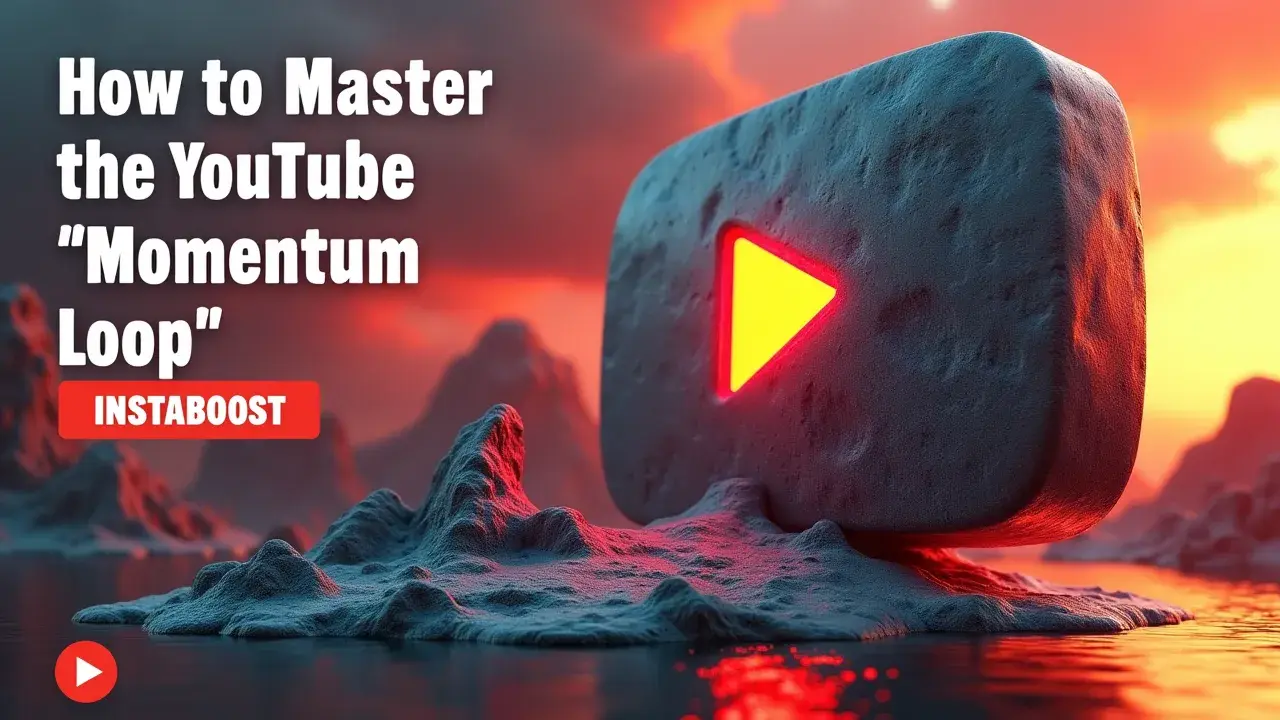How To Master the YouTube “Momentum Loop” Effectively?
Mastering the YouTube “Momentum Loop” relies on reinforcing consistent signals across uploads. Prioritize strong first-hour engagement, keep topics cleanly focused, and aim for rising session time by aligning titles with viewer intent. Treat each upload as a test and iterate, targeting three consecutive videos that sustain retention past 50% for a noticeable lift. Consistent cadence, repeatable formats, and small retention gains compound into trust and steady growth.
Start Fast, Then Compound
The Momentum Loop is the flywheel you build when each upload strengthens the next, and it works when you engineer repeatable early wins that feed the recommendation system instead of chasing a single viral spike. Treat every video like a measured test. Keep the topic tight, make the hook land fast, and protect retention past the halfway mark. That first hour matters more than most admit. When your title and thumbnail set accurate expectations and match viewer intent, real comments and likes arrive quickly, session time climbs, and YouTube’s browse features surface your video to more of the right viewers. Paid accelerants can help if they’re reputable and matched to true interest, and it’s worth sanity-checking any tool you consider to boost YouTube video with strict criteria like transparent targeting and clean attribution.
With safeguards like tight geos, device filters, and excluding low-quality placements, they can seed watch history without muddying your analytics. The loop tightens when each video points to the next through creator collabs, end screens, and pinned comments that make continuity effortless. Cadence beats bursts. A reliable schedule and a repeatable format build anticipation and give you clean analytics to iterate on. Track what actually compounds – average view duration, audience retention dips, CTR against impressions, and returning viewers – so your testing loop is guided by evidence, not anecdotes. If a piece underperforms, adjust the pairing that failed. Refine the opening 30 seconds, retitle to match search intent, or add a relevant collaboration to widen qualified reach. Measured this way, small retention gains outpace novelty, turning consistent engagement into rising session time that powers YouTube growth and closes the loop.

Prove You’ve Done It: Borrowed Credibility, Clean Data
I learned this while fixing someone else’s mess. A channel with solid ideas kept resetting the algorithm’s trust because every video felt like a genre pivot, thumbnails overpromised, and the first hour spiked but felt hollow. We stabilized it by stacking small, honest wins and importing credibility the right way: relevant creator collabs, pinned comments from qualified voices, and targeted promotion to an audience matched to intent, not just cheap traffic. Those pairings work when your title – thumbnail combo sets accurate expectations, your first 30 seconds deliver the hook you promised, and your retention past the halfway mark stays clean.
Clean means no inflated CTR from bait, no paid viewers who bounce, and comments that reference specifics in the video, which is also why I ignore schemes that promise to buy high-retention YouTube subscribers and instead judge any accelerant by how it affects average view duration and session lift. The Momentum Loop compounds only if your data is trustworthy. Otherwise YouTube learns the wrong thing.
So set safeguards. Run unlisted A/B tests for thumbnails, use short geo-limited ads to likely fans instead of broad blasts, and segment analytics to isolate effects across new vs. returning viewers and browse vs. search. If you want fast proof, line up a micro-collab with a creator whose audience overlap is real, then deliver a format in your lane – same topic, tighter angle, sharper payoff. Their intro lends borrowed trust. Your delivery earns it. It’s valid to pay for accelerants when they’re reputable, qualified, and measured against retention and session time, not vanity CTR. Treat each upload as a test in a repeatable format, publish on a cadence you can sustain, and aim for three consecutive videos with retention above 50%. That’s when the YouTube Momentum Loop starts to feel like a tailwind instead of a gamble.
Design a Repeatable Testing Loop
You don’t need more features. You need more clarity. Treat the Momentum Loop like a lab: one format, one promise, and one clean variable per upload. Lock your topic lane for a short sprint – five videos with the same viewer intent – and iterate on what YouTube actually reads: title – thumbnail alignment, the first 30 seconds, and retention past halfway. Start with a simple A/B cadence. Test two thumbnails for the same title in the first hour, then swap the laggard only if the CTR gap holds after 200 – 300 impressions.
Keep the hook literal to the promise. Name the outcome, show the proof, then bridge to the tutorial or story. Protect session time by front-loading the payoff and pushing tangents later. Anything that doesn’t drive the core outcome lives after minute six or in a follow-up. Use targeted promotion as an accelerant, not a crutch. Send reputable, intent-matched audiences – newsletters, relevant subreddits with posting guidelines, or creator collabs – to the episode that best matches their problem, and remember that lightweight social signals can nudge browse to test you a bit wider than usual, which might happen when viewers increase video reach with likes without distorting intent.
In analytics, watch the first 60 seconds’ drop-off shape, CTR by surface, and average view duration relative to length. Aim for three consecutive uploads with 50%+ retention to signal stability. If you use paid distribution, choose small, skippable placements aimed at exact keywords and switch off auto-expansion. It works when you measure downstream session time, not just clicks. The quiet advantage is that a repeatable format gives you faster learning cycles, so each micro-win stacks, your YouTube growth stops relying on luck, and the flywheel starts to pull you instead of the other way around.
Resist the False Positive: Viral Blips Don’t Mean Product-Market Fit
My strategy has mostly been vibes and late-night panic, which is how a lucky spike gets mistaken for proof that the Momentum Loop is solved. One viral short, a paid blast, or a shoutout can tilt your read. CTR looks heroic, comments gush, then the follow-up underperforms because the audience was mismatched or the promise shifted. Push back on the sugar high. Buying traffic, funding collabs, or running ads can accelerate when you add safeguards. Target viewers whose intent matches your topic lane.
Pair the promotion with a title and thumbnail that set accurate expectations. Verify that retention past halfway doesn’t crater. Real signals are steady and a little boring: watch time per impression rising, repeat viewers climbing, and comments referencing the hook you delivered in the first 30 seconds. Treat every accelerant as a tool in your testing loop, not a verdict. Two thumbnail variants? Swap only when the CTR gap holds after 200 – 300 impressions and your average view duration stays steady.
Creator collab? Choose partners whose audience already consumes your format, then pin a comment from that qualified voice to anchor borrowed credibility. If you chase genre pivots for a bump, the algorithm reads fragmentation and resets trust. The smarter move is to lock viewer intent for a five-video sprint and prove durability. Three uploads in a row with retention past 50% and clean analytics beat one bursty outlier. The non-obvious part is that early momentum on YouTube compounds when session time rises after your video, so craft endings that bridge to your next upload in the same lane. That pairing, plus honest expectations, turns a spike into a system.
Lock In the Compounding Signal
You don’t need to be fully ready – you just need to be moving. The Momentum Loop rewards creators who build clean, repeatable signals and stack them, so the finish is simple: commit to a cadence you can hit without quality debt, then compound small wins. Three uploads in a row that hold retention past halfway often beat one big spike for channel growth because YouTube reads consistency as confidence. Pair your testing loop with safeguards. Verify title – thumbnail alignment against real comments, watch audience retention for the first 30 seconds and the back half, and use targeted promotion when it matches the promise of the video; in some cases, third-party shares can expand your video visibility on YouTube without skewing the intent if they mirror the audience you’re training.
Paid boosts and creator collabs can be useful accelerants if they’re reputable, timed to the first hour, and aimed at the same viewer intent you’ve been training – mismatched traffic muddies analytics and slows learning. Keep the lab clean by measuring CTR deltas after at least 200 – 300 impressions before swapping a thumbnail, and annotate any external pushes so you can filter results later. The non-obvious edge is that momentum is session-based, not just video-based. If your end screens and pinned comments move viewers to the next piece in the same topic lane, you lift session time, which is the quiet lever that makes recommendations stick. When a format starts showing repeatable retention and genuine comments, lock it for a five-video sprint and avoid rewriting the promise midstream. Use YouTube search data and audience tab insights to tighten phrasing, then scale the cadence only after the edit workflow holds. The loop works when you trade novelty for reliability – clear cadence, aligned traffic, clean analytics. That’s how steady signals compound into durable momentum.















